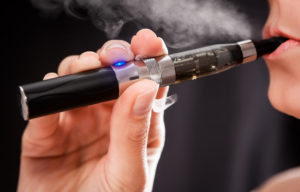E-Cigarette Makers Contending with New CPSC and FDA Regulations
 Products like e-cigarettes and other electronic nicotine delivery systems (ENDS) have been under intense scrutiny in recent years from public health officials, legislators at all levels of government, and many other interested parties, including dozens of plaintiffs in lawsuits stemming from battery explosions and other injuries. Newly enacted Federal requirements for ENDS and their components and parts show that such scrutiny sometimes leads to legislative or administrative actions. Indeed, Summer 2016 could down in infamy for manufacturers, distributors, and retailers of this category of consumer products due to its confluence of new regulations from two major Federal agencies - CPSC and FDA.
Products like e-cigarettes and other electronic nicotine delivery systems (ENDS) have been under intense scrutiny in recent years from public health officials, legislators at all levels of government, and many other interested parties, including dozens of plaintiffs in lawsuits stemming from battery explosions and other injuries. Newly enacted Federal requirements for ENDS and their components and parts show that such scrutiny sometimes leads to legislative or administrative actions. Indeed, Summer 2016 could down in infamy for manufacturers, distributors, and retailers of this category of consumer products due to its confluence of new regulations from two major Federal agencies - CPSC and FDA.
We previously reported on the Child Nicotine Poisoning Prevention Act of 2015, introduced last year by Senator Bill Nelson (D-Fla.) and signed into law in January. It requires liquid nicotine to be packaged in accordance with the Poison Prevention Packaging Act and CPSC's standards child-resistant packaging and containers (children are those under age five). The new law defines a liquid nicotine product as a "package from which nicotine in a solution or other form is accessible through normal and foreseeable use by a consumer and that is used to hold soluble nicotine in any concentration.”
Requirements under the Child Nicotine Poison Prevention Act just went into effect on July 26, 2016. Now, in addition to complying with the new container and testing standards, manufacturers who sell liquid nicotine products also have to implement a General Certificate of Compliance (GCC) for each liquid nicotine product as required by the Consumer Product Safety Commission. The GCC must certify that the manufacturer is in compliance with the new child-resistant packaging requirements and be provided with every shipment of the covered products.
The other Federal agency implementing new authorities over e-cigarettes and ENDS right now is the Food and Drug Administration. Back in May, FDA finalized its so-called Deeming Rule, to bring these types of products within the authority granted to FDA by the Tobacco Control Act of 2009 to regulate “tobacco products." The more common forms of tobacco (like cigarettes and roll-your-own) were immediately subject to the provisions of the Act when it was passed. However, it also provided FDA with the authority to “deem” other tobacco products to fall under the Tobacco Control Act. The Final Deeming Rule published in May extends that authority and all regulatory requirements thereunder to: cigars, pipe tobacco, hookahs, dissolvable products, e-cigarettes, and other ENDS, as well as to any components or parts of those covered products.
FDA's Deeming Rule goes into effect in about one week - on August 8, 2016 (the Effective Date). Among other interlocking compliance requirements for tobacco products and several provisions related to limiting youth access to covered products that we are not describing, as of that date:
- E-cigarette manufacturers and distributors will be prohibited from distributing free samples of their products;
- E-cigarette manufacturers and distributors will be required to register their manufacturing establishments with FDA and list their products;
- Manufacturers will be required to submit ingredient lists to FDA and report harmful and potentially harmful constituents; and
- New warning label statements about tobacco-addictiveness will be required on packaging and in advertisements. Those warning statements apply only to “covered tobacco products,” which excludes any component or part that is not made or derived from tobacco.
In addition, August 8, 2016 is a critical date for all newly deemed tobacco products, because they are now subject to premarket authorization from FDA. The Agency has implemented that market authorization requirement as follows:
- Tobacco products that were on the market prior to Feb. 15, 2007 are grandfathered in and do not require any sort of premarket authorization.
- Tobacco products that were on the market before the Effective Date (Aug. 8, 2016) but were not on the market as of February 15, 2007 are required to obtain premarket authorization. For these products, FDA has provided two compliance periods – the first is a deadline for an application to be submitted and the second is a deadline for receiving authorization. FDA has no plans to take enforcement action against any products that remain on the market during these compliance periods provided that applications are submitted; the Agency also has stated its intention to review all these incoming applications expeditiously.
- Tobacco products that were not on the market as of the Effective Date cannot be introduced without marketing authorization from FDA and will be subject to enforcement if distributed and sold without authorization after August 8th.
At this time, however, FDA is limiting its enforcement efforts to finished tobacco products like a finished ENDS or e-cigarette, which means that components and parts of ENDS that are sold or distributed solely for further manufacturing into finished products, and that are not sold separately to the consumer have additional time to comply and no presently announced deadline.
So in short - lots going on for everyone involved in this industry! Even entities not directly affected by the new rules should consider, for example, whether they need to add more specific reps and warranties related to regulatory compliance in their supply agreements with ENDS manufacturers.

